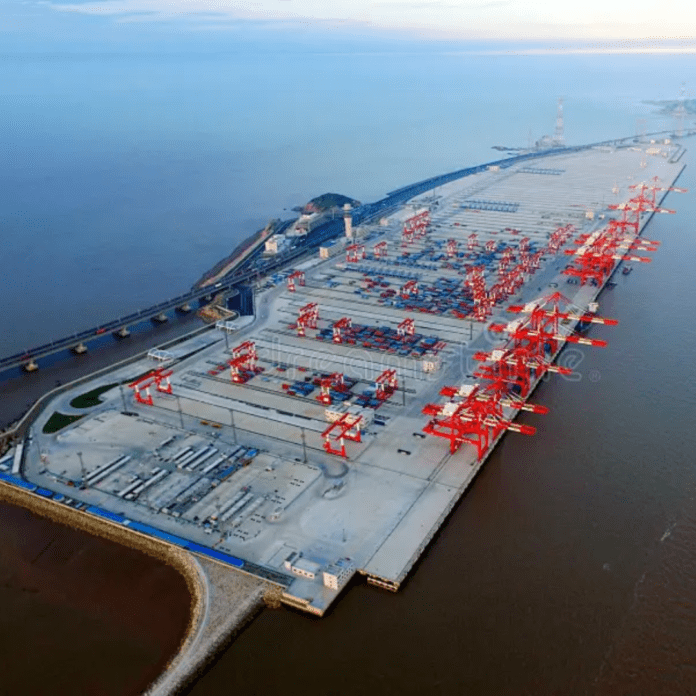Making a simple stretch of sea 30 kilometers into a mega-port offshore in the Hangzhou. Bay near Shanghai, Yangshan Port is one of the most amazing engineering feats China has created. Featured on the Spark’s Megastructures series by a documentary entitled. “Yangshan: How China Built A Mega-Port 30km Out At Sea”, this will prove to be an epitome of innovation and capability. In terms of maritime infrastructure development for a country like China.
Yangshan Port: Vision and Construction
At the beginning of the 2000s, a way to relieve congestion and shallow draft of Shanghai’s existing ports was conceived. Yangshan Port, the first of its kind Was then chosen to be built on a group of islands. Connected by bridges and tunnels, offshore. Besides increasing Shanghai’s capacity. This solution kept disruption to the urban environment more or less at bay and increased logistical efficiency.
Engineering Marvel of Yangshan Port
The first reason for the success of Yangshan Port is its world-class infrastructure. The entire complex is recline across several islands. All of which are connected to mainland China by the Donghai Bridge the second-longest sea bridge in the world. This integrated network ensures smooth transportation between the port and inland China, facilitating quick and efficient cargo handling.
For Yangshan Port, massive land reclamation and dredging. To produce a deepwater harbor ready to accept the world’s largest container ships, it had to be done. Engineers surmounted colossal challenges posed by strong tidal currents and threats of typhoons. With challenging techniques to guarantee the stability and functionality of the port.
The Yangshan Islands, collectively belonging to the Zhoushan Archipelago, situate the port. Phases of Construction of the port began in 2002 and done in phases. In 2005, we completed the first phase of the project. Subsequently, we increased the capacity and facilities of the port during the following phases.
Infrastructure and Facilities
Breakwater: There is a gigantic breakwater at the port, which saves it from the rough sea conditions of the East China Sea. This breakwater is essential to maintaining calm waters inside the port area.
Terminals: Yangshan Port has a number of deepwater berths and terminals that are able to handle the largest container ships of their class in the world. These terminals have the most modern cranes and automated systems, ensuring increased efficiency in loading and unloading cargo.
Technical Specifications
Water Depth: The deep-water port has a water depth which can go as much as 15 meters. Thus capable of accommodating the ultra-large container vessels. ULCVs which require considerable drafts.
Area: The port area is very expansive. With many terminals and storage houses credential to its huge expansion on the Yangshan Islands.
Capacity: Yangshan Port has drastically increased the overall capacity of the Port of Shanghai, credentialing it to the ranking of the world busiest and largest by Container Throughput.
Importance
Economic Impact: The port has been a very important platform for international trade. And functions as one of the major nodes of the worldwide shipping network. Such institutions, suitably manipulated with advanced infrastructure. Have been among the major facilitators of China’s economic growth and its preeminent position in world trade.
Technological Innovations: Yangshan Port is deploying state-of-the-art technology, comprising automation and artificial intelligence, to maintain its operational efficiency without human intervention.
Operational Significance
Since its inauguration, Yangshan Port has played a significant role in the Chinese maritime trading landscape. It serves as the ‘front door’ of international freight transport, shipping diverse products around the globe. It is advantageously positioned to provide a straight entrance to the main sea lanes. Thus enhancing the economic competitiveness of China in the global supply chain.
Future Expanding and Integration
In the near future, there will be further expansion of Yangshan Port and its integration with the Chinese initiatives of the Belt and Road Initiative. Asian countries’ connectivity and trade relations with us are envisioned to become stronger and more extensive. Improvements in port facilities and infrastructure are due for higher shipment volumes and changes in trade patterns related to the future.
Global Impact
The Yangshan Port success story is much more than local in scope. It has demonstrated the higher ambitions of China regarding infrastructure development and maritime commerce. Showcasing a model for countries looking to upgrade their port infrastructures and connectivity. As China pressed on with its massive investments in coastal infrastructure projects. Yangshan Port became an icon for the engineering at work and strategic vision that propels the emerging nation.
Ultimately, Yangshan Port stands to epitomize the ‘can-do’ Chinese spirit of conceiving and delivering. What would appear to be seemingly impossible infrastructure initiatives. That push boundaries and change perspectives in maritime engineering. Construction and operational success characterized the relentless pursuit of sustainable development. Efficient logistics, and global economic integration through innovative infrastructure solutions in China.


